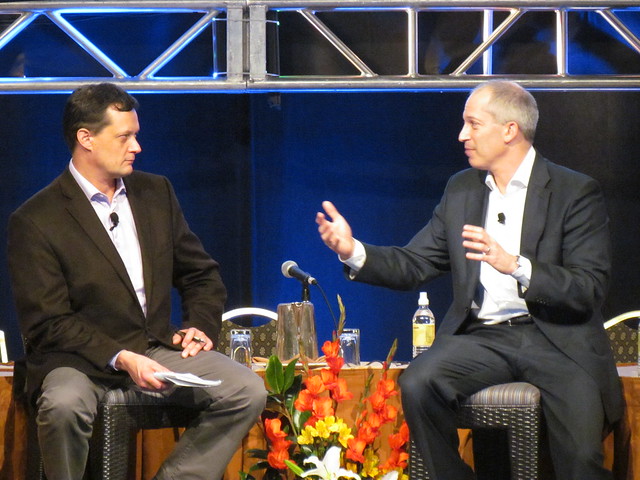
To kick off the afternoon of Day 2 of our ILM West Conference, YP CEO David Krantz outlined the company’s post spin-off positioning and outlook.
For those unfamiliar, YP was spun out of AT&T via private equity (Cerberus Capital), and now sits under the corporate entity YP holdings. Independence from AT&T is meant to create value in being free from lots of debt and legacy product creep.
“In many ways, we are a startup, but a 6000 person startup,” said Krantz. “We now have more effective focus, and are a $3 billion advertising company. We’re one of the biggest internet companies that many people have never heard of.”
This brings together a digital product bundle, an in house tech & innovation house (formerly AT&T interactive), and 3000 digital ad sales reps. That comes together in the $200 billion in annual commercial offline transactions that are associated with searches on YP properties.
Krantz espoused four main points that comprise the strategy to bring this all together:
1. Consumer Reach: This goes back to the classic fragmentation challenge in local media that divides up the ability for companies to scale up their audiences (and advertisers). That reach includes being strong accross geographies and in different ad formats that reach different users (display, search, social, mobile,etc.).
YP is achieving this across its network of owned and operated properties (print, YP.com, YP Mobile), as well as its affiliate network (search, mobile apps, etc.)
2. Sales Presence: To balance out all the above ad inventory with some decent advertising and fill rates, the other side of the equation involves reaching that local SMB long tail. And one of the only ways to do that is direct touch points to that fragmented market.
And hand holding is needed for SMBs that are busy fixing cars and cooking meals. Krantz here espouses an old saying in local that continues to ring true: “Local advertising isn’t bought, it’s sold.
3. Advertising Services: The above is tied together with a well crafted package of advertising that runs a spectrum of different price points and levels of complexity. This includes SEM, SEO, online and mobile websites, display ads, presence management, coupons, print and direct mail. “It has to make sense and be easy to buy,” says Krantz.
4. Technology: to underpin and deliver it all.
The last point is an important one, so that all of these products aren’t just lip service: it has to be fulfilled, perform and not fall apart; or the entire exercise is pointless.
“We think connecting 300,000 advertisers and 70 million consumers is a pretty unique thing if you can create meaningful experiences,” said Krantz. “These are networks and our goal is to create network effects.”


This Post Has 0 Comments